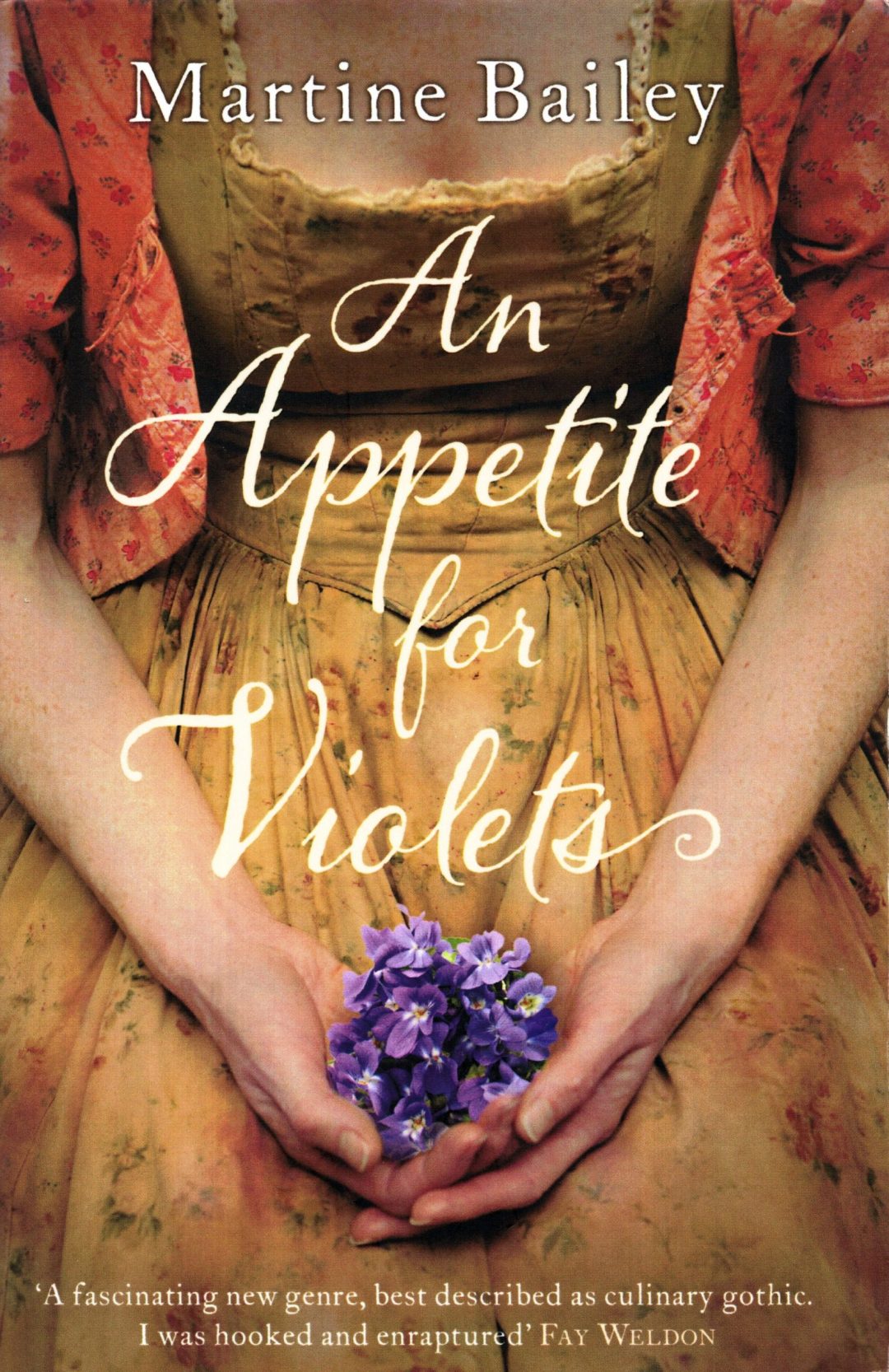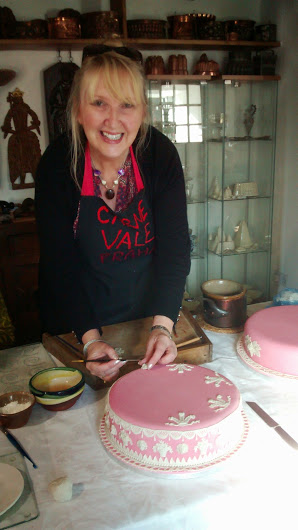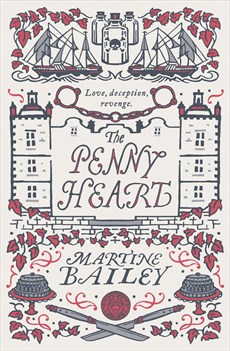Interview with author Martine Bailey
Author Martine Bailey has created a new fictional genre; in Fay Weldon's words 'culinary gothic'. Here, she talks about her first book An Appetite For Violets, with a spirited, feminist heroine at its hilt

Described by Fay Weldon as ‘culinary gothic’, author Martine Bailey’s debut novel An Appetite for Violets, is set in the late 18th century, with food as the central theme, along with layers of mystery, intrigue, larger-than-life characters and an engaging writing style that draws the reader into this fictional world and makes the story unputdownable.
The heroine, Biddy Leigh, is a spirited, courageous lass from Lancashire, who works as an undercook at stately home Mawton Hall. When she gets a new mistress, she must accompany her to Italy, and she goes armed with an old household book of recipes, The Cook’s Jewel, in which she records her observations. She soon finds herself embroiled in a dangerous plot with many twists and turns – will the secrets she holds be the key to her survival or her downfall?
We spoke to Martine Bailey about the inspiration for the novel and how she fused her love for food and literature.
Can you tell us about the inspiration behind the story – Erddig Hall in Chester? And about your passion for food and historical cookery?
The idea for An Appetite for Violets came to me in the beautiful 18th-century kitchen of the National Trust property, Erddig Hall. I picked up a few hand-written recipes for roast venison and almond pudding and felt they brought the past vividly to life. I pictured a clever young cook working at the scrubbed table, who would be wrenched from her comfortable life and use her talents to survive. I wanted to evoke a world of lost recipes, an account of a journey to foreign lands spiced with plot twists and murder.
I originally started baking to save money and feed my son, making traditional specialities like Bakewell Tart, gingerbread and fruitcakes. Then one day, I entered a Merchant Gourmet contest with a Spanish dish for a Smoky Asturian Stew. I was amazed to win; the prize was a cookery course in Provence, France. One thing led to another and I began learning more about historical food, eventually cooking at Le Meurice in Paris as a UK Dessert Champion.

Biddy is such a likeable character and the language she uses so colourful and convincing. How did you research her? Can you tell us about how you learnt to cook 18th-century food?
Biddy only really sprang to life when I gave her my own childhood Lancastrian accent. I remembered how my granddad used to joke in the language of his youth, all ‘lass’ and ‘thou and thee’, a rhythmic, poetic sort of burr. Also, Biddy lives and breathes food, so I collected lots of slang, proverbs and culinary terms to create her world.
Initially, I gathered lots of recipes but didn’t know how to make them. I contacted TV food historian Ivan Day and went to his Cumbrian farm where he makes amazing sugarwork, cooks on a fire and recreates intricate pies, sweets and jellies. I’ve made dishes I write about, such as Taffety Tart, a pastry with apples and quince that was once more popular than apple pie. Other favourites are Soul Cakes, eaten to appease the dead on All Hallows’ Eve as part of a very ancient tradition.
Biddy seems to be an early feminist icon; she is a servant so is limited by her station, but she is daring, clever and capable, and she has the courage to follow her dreams. Did you consciously set out to create a strong female protagonist?
I really hate it when historical heroines have completely 21st-century attitudes, but the records show that servants ‘aped their betters’ and were often ‘pert’ or ‘saucy’. Biddy is also typical of a new breed of women cookery book writers who were emerging as entrepreneurs and understood what the new middle classes wanted. So yes, I wanted to Biddy to be brave, sharp-witted and a match for her superiors. She is also rather typically Lancastrian, if you think of TV’s Coronation Street, which my Dad worked on, with its strong outspoken female characters giving back-chat behind bars and shop counters.
Though I couldn’t find a memoir written by a female servant, I did find an autobiography by an exuberant footman who influenced me to be upbeat about life in service. He loved his time as a traveller and womaniser at others’ expense; there must be few other memoirs that conclude, ‘I thought my life was heaven on earth.’ [Memoirs of an 18th Century Footman by John Macdonald]
In a world ruled by men, the recipes that women had written seem to be the only surviving record of their lives and the big events – marriage, childbirth, death – that marked them. Did you set out to give a voice to these women?
Yes, I did. I find it poignant that recipes are often the only surviving marks on paper left by unvoiced women. I wanted to convey the way they transmitted women’s pleasures down the generations, passing on moments of happiness in hard-won lettering and precious ink. I also tapped into my own emotions when treasuring handwritten family recipes that represent ‘love on a plate’.
What fascinated me especially was the rambling, poetic language of those early recipes, often collected in a Household Book for a young woman’s marriage. Many are highly personalised, such as ‘Mary Jones, Her Second Best Cake’ and of course, lack all temperatures and instructions, just ‘bake till enough’ or ‘add to your taste’. One of my favourite instructions is to use prayers to time a process: ‘boil for one Hail Mary’, means 15 -20 seconds.
I especially looked for recipes that guided women through different rites of passage in their lives. Old recipes tell us there were hot drinks or caudles to help give birth, bride cakes at weddings and funeral cakes to eat when life ended.
Why did you choose violets, as opposed to, say, roses, to be the central food symbol of the novel?
The idea for the title began with a recipe for Violet Pastilles in an old recipe book. It seemed such an old-fashioned and rather decadent flavour, ideally representing Biddy’s secretive mistress and her addiction to sugar and fashion. Floral flavours were the height of elegance, so when Biddy makes ice creams using jasmine and honeysuckle she was absolutely on-trend!
Then in the final scenes, the scent of violets has another more disturbing significance. I chose violets to symbolise the final twist in the novel, because there is something about that ‘Parma violets’ scent and flavour that many people find slightly sickly and unsettling. So violets represent something corrupt, that the reader finally understands lies at the heart of the mystery.
With so many layers to the novel – servants and masters, slavery, travel, food, deception, women’s place in the world, romance – how did you keep it all organised? Can you tell us a bit about how you plotted and planned the novel? Did you spend a long time researching?
In An Appetite for Violets, my intention was to fuse a colourful historical novel with the type of plot more usually found in crime and mystery fiction. Firstly, my husband and I spent four annual holidays travelling along different stops on the route from London to Paris, then Lyon, Savoy, and Tuscany. I used a 1756 edition of Mr Nugent’s The Grand Tour to compare the past and present, and visited museums and inns and restaurants. There was so much fascinating detail, for example that a ‘restaurant’ was originally a type of health-giving broth, made to ‘restore’ the health, served in Paris in the late 18th century.
However, all of this created far too much material! I used magazine boxes labelled France, Servants, Costume, and so on, to organise my papers. Then I used big divided notebooks and drew mind maps to plan each chapter. I write best in the mornings and go quite slowly, weaving themes, plot-lines and character development together. I then print out what I’ve written and revise it many times, often reading the dialogue out loud. It sounds laborious but when the story is flowing, it can be painful to wake up in the 21st century…
The conclusion was satisfying too – there were no loose ends and no ‘easy ways out’ for the characters either; as you were plotting the story, did you know what the outcome would be for all the characters? Or did they take on a life of their own?
I had a vague idea of the end, but I love twists and turns and even I didn’t see some of them coming. I did an excellent Arvon Fiction Writing course in Devon and the advice was to write backwards, so start with ‘whodunit’ and then elaborate and mystify the reader as you work back to the beginning. That is the theory, but in practice it isn’t that easy – because my characters did develop minds of their own.
The final drafts involved ensuring clues and misdirection were carefully seeded, making me wonder how writers managed before they could ‘cut and paste’. All of this used up a lot of coloured highlighters, post-its and fried a few brain cells, but it is very enjoyable when people say: “ah, I never saw that coming”.
What was it about Italy that made you think Biddy should start her new life there? Was it to do with Italian food, or the soul and passion of the country that suited Biddy’s temperament?
Like most rather sardonic characters, Biddy is secretly romantic and, as a single woman, she finds herself wondering if she will ever find love. So when she gets to Italy and lots of unexpected events occur, I thoroughly enjoyed imagining those romantic scenes and her internal struggles. I think we British still see Italy as an Arcadian paradise – our country houses and gardens are modelled on their villas, and so much of our history is based on classical ideas. I had a bit of fun with that; the notion that while classicists studied Roman columns, Biddy’s dreams are the sugarpaste temples that were the centrepiece of grand Italian banquets.
Having just returned from a holiday in Tuscany, I’d also say that the food is now even better than French cuisine! And what more could you ask for than those unsurpassable views of hilltop fortresses, vineyards and cypress trees?
Your next book, The Penny Heart, has recently been published. Can you tell us a bit about it and what we can expect?

The Penny Heart is the story of a naive young wife who employs a new and sinister cook. It is narrated firstly by Grace, a sensitive and artistic young woman who finds herself at isolated Delafosse Hall, horribly attracted to her selfish husband, Michael. The alternate strand follows Peg, her housekeeper, a clever cook and – the reader realises – a talented confidence trickster. When Grace finds a Penny Heart, an old penny engraved with a sinister verse, it draws her into a world of deceit that culminates in murder.
Like Grace, I love Gothic novels so it was a pleasure to explore mouldering, isolated Delafosse Hall, and describe sinister servants, an underground tunnel and themes like the Hangman’s Supper. I also wanted to show the uneasy 1790s, when the French Revolution was threatening British peace of mind. Propertied but powerless women such as Grace were vulnerable to the material greed of their partners. Working class criminals like Peg, on the other hand, took what they could of Britain’s fabulous new wealth. Peg takes an oath to follow what was called The Life – learning the secret language of rogues and wearing hidden tattoos as part of a vibrant underclass.
I was fortunate to write much of The Penny Heart in Australia and New Zealand while I house-swapped for nearly two years. The research took me to locations such as Sydney Cove and the wild bush and beaches of New Zealand. Food is again a big theme, especially its darker aspects, the secret women’s world of elixirs, aphrodisiacs and poisons.
Martine Bailey’s historical novels, An Appetite For Violets and The Penny Heart, are available now in paperback and as eBooks from Hodder & Stoughton. Find out more at www.martinebailey.com and by following her on Twitter @MartineBailey.
Martine will be appearing at Knaresborough Feva Festival giving an illustrated talk on historic food in her novels on Thursday 20 August at 7pm, call 01423 866886 or click here for more information.








